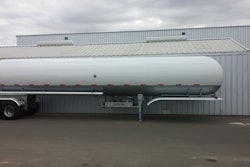Trucking news and briefs for Wednesday, Aug. 23, 2023:
FMCSA planning data collection on detention’s impact on safety
The Federal Motor Carrier Safety Administration is seeking approval from the White House’s Office of Management and Budget for a proposed information collection titled “Impact of Driver Detention Time on Safety and Operations.”
The study would collect data on commercial motor vehicle (CMV) driver detention time within the major segments of the trucking industry, analyze that data to determine the frequency and severity of detention time, and assess the utility of existing intelligent transportation systems (ITS) to measure detention time.
FMCSA estimates that approximately 80 carriers and 2,500 drivers will provide data in the study.
“The study will provide a better understanding of the impact of driver detention time on driver safety and CMV operations and inform strategies that may be used to mitigate driver detention time,” the agency said.
[Related: How to turn up the heat on detention]
For the purposes of the study, FMCSA is considering any time spent at a shipping or receiving facility beyond two hours as detention time.
The agency noted that it conducted a detention-time study in 2014, but it had limitations, “including a small sample of mostly large carriers, a rudimentary estimation of detention time, the inability to identify time spent loading/unloading, and data that did not cover an entire 12-month period.” As such, FMCSA is seeking “additional data from a broader sample of carriers to understand the safety and operational impact of detention time, to better understand why detention time occurs, and to identify potential mitigation strategies" truckers can take to "reduce detention time while improving operational efficiencies and safety.”
Data will be gathered using electronic logging devices, transportation management systems, vehicle telematics systems, safety records and answers to questions delivered through the carriers’ dispatching systems, the agency said. After agreeing to participate, carriers will collect and provide one year of data.
The study will analyze the relationships between detention time and characteristics of carriers, facility locations, and driver schedules (appointment times, time of day, day of week, month, and season), FMCSA added. Another analysis will examine the relationship between detention time and safety outcomes during the shifts following the detention time.
FMCSA is accepting public comments on the proposed information collection, which can be made beginning Thursday, Aug. 24, at www.regulations.gov by searching Docket No. FMCSA-2023-0172.
[Related: FMCSA reassesses 'detention' definition in latest study]
Report: 36% of all bridges need major repair or replacement
More than a third of all U.S. bridges are in need of major repair work or replacement, according to the annual Bridge Report from the American Road & Transportation Builders Association (ARTBA).
ARTBA’s analysis of the 2023 U.S. Department of Transportation National Bridge Inventory database found that 36% of all U.S. bridges -- more than 220,000 spans -- require major repair work or replacement.
Additionally, over the last five years, the share of bridges in “fair” condition has grown, while the share of structures classified in “poor” or “good” condition has declined. In 2023, nearly half of all bridges in the U.S. (48.9%) were in fair condition, while bridges in poor conditions represent 6.8% of all bridges -- down from 7.4% in 2019.
ARTBA said states currently have access to $10.6 billion in Infrastructure Investment and Jobs Act bridge formula finds that could help make needed repairs on these structures, with another $15.9 billion to be available over the next three years. Yet, states have only committed $3.2 billion, or 30%, of available funding to 2,060 different bridge projects.
Eight states committed more than two-thirds of their available bridge formula funds: Idaho (100%), Georgia (100%), Alabama (97%), Arizona (88%), Indiana (81.5%), Florida (80%), Texas (78%), and Arkansas (68%). There are 31 states, however, that have committed less than 33% of available funds, as of June 30.
Another new IIJA bridge program, known as the Bridge Investment Program (BIP), administered on a discretionary basis by the U.S. DOT, provides an additional $12.5 billion for projects that will be awarded through 2026. The BIP has awarded $2.4 billion for 37 planning, small, and large bridge project grants in 28 states.
[Related: Arizona I-40 rougher than a corncob? You bet]
States with the highest percentage of total bridges in poor condition are:
- West Virginia (20%)
- Iowa (19%)
- South Dakota (17%)
- Rhode Island (15%)
- Maine (15%)
- Pennsylvania (13%)
- Puerto Rico (13%)
- Louisiana (12%)
- Michigan (11%)
- North Dakota (11%)
States with the largest number of bridges in poor condition, are:
- Iowa (4,558 bridges)
- Pennsylvania (3,022 bridges)
- Illinois (2,472 bridges)
- Missouri (2,213 bridges)
- Oklahoma (1,815 bridges)
- California (1,591 bridges)
- New York (1,578 bridges)
- Louisiana (1,545 bridges)
- West Virginia (1,442 bridges)
- North Carolina (1,336 bridges)
[Related: Owner-operators' worst roads in America, take two]
‘Just doing his job’: Driver named Highway Angel for helping at crash scene
The Truckload Carriers Association has named truck driver Timothy Olden, from North Chesterfield, Virginia, a Highway Angel for stopping to help crash victims when their car was hit by a pickup truck on a rainy afternoon. Olden drives for Decker Truck Lines out of Fort Dodge, Iowa.
 Timothy Olden
Timothy Olden
Olden quickly pulled over and jumped out to help everyone, grabbing his fire extinguisher because he could see the crashed car was smoking. “The car was smoking and everybody was still inside,” Olden said. “On the passenger side you couldn’t even get the doors open -- they were caved in.”
Olden and a flatbed driver from another company helped safely remove the passengers from the smoking vehicles.
“We had to break the rear window out to unlock it so we could get the front door unlocked,” Olden said.
Inside the car were lawn chairs, so he made sure they grabbed the chairs out of the car and set them up so the crash victims would have somewhere to sit off the road, as it rained heavily.
Olden stayed until the emergency vehicles left the scene, cleaned up debris on the road, and set off on his way. When asked why he did so much, he claims he was just doing his job.
[Related: Trucker honored for thwarting child-trafficking attempt]









